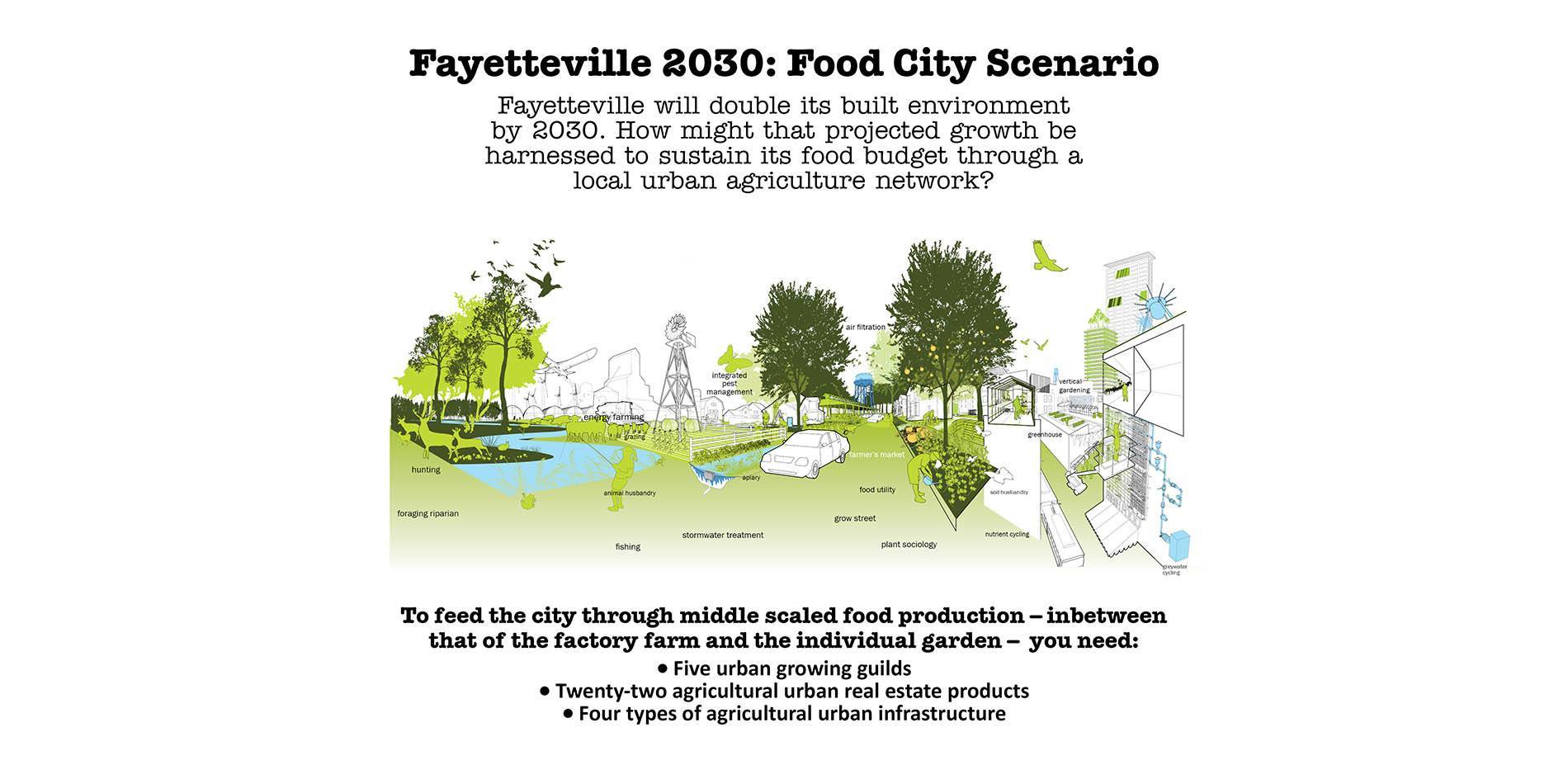
Fayetteville will double its built environment by 2030. How might that project growth be harnessed to sustain its food budget through a local urban agriculture network?
Photo Credit: University of Arkansas Community Design Center
Media: Please submit high-resolution image requests to images@asla.org.
28% of Fayetteville children are food insecure, the highest rate in the nations. Food City realigns growing technologies with urban areas to meet future needs.
Photo Credit: University of Arkansas Community Design Center
Media: Please submit high-resolution image requests to images@asla.org.
Twenty-Two Agricultural Urban Real Estate Products. Food City adds these hybrid alternatives to the nineteen standard real estate product types constituting mainstream land development (see Christopher Leinberger’s list in his The Option of Urbanism: Investing in a New American Dream).
Photo Credit: University of Arkansas Community Design Center
Media: Please submit high-resolution image requests to images@asla.org.
Middle scale urban food production requires four new types of infrastructure.
Photo Credit: University of Arkansas Community Design Center
Media: Please submit high-resolution image requests to images@asla.org.
1 Nutrient Management Infrastructure “…the next green revolution may come from optimizing the soil.”
Photo Credit: University of Arkansas Community Design Center
Media: Please submit high-resolution image requests to images@asla.org.
1 Compost Campus. These territories are structured around citywide resource recovery and upcycling to reclaim essential biological macronutrients – phosphorous, nitrogen, and potassium-from waste
Photo Credit: University of Arkansas Community Design Center
Media: Please submit high-resolution image requests to images@asla.org.
2 Growing Media and Infrastructure. “In traditional soil farming, the key limiting factor is the active transportation of nutrients to the roots. Freshwater aquatic systems are ideal media for vegetation.”
Photo Credit: University of Arkansas Community Design Center
Media: Please submit high-resolution image requests to images@asla.org.
2 Lake Neighborhood. Integrated Pond Systems. The infrastructure for sustainable aquaponics doubles as a development amenity for neighborhoods. Aquaponics harness the lake’s ecology, including cultivation of wetland landscape guilds, to address one of the biggest problems associated with aquaculture: management of fish waste.
Photo Credit: University of Arkansas Community Design Center
Media: Please submit high-resolution image requests to images@asla.org.
2 GROW street: Gardened Right-Of-Way. The desire and ability to produce food is socially transmitted. Gardened Right-Of-Ways privilege food production and other non-traffic functions within the street yet still accommodate vehicular uses.
Photo Credit: University of Arkansas Community Design Center
Media: Please submit high-resolution image requests to images@asla.org.
3 Waste Recovery Infrastructure. “The vast majority of our local food systems are not self-reliant or self-sustaining in terms of fertility inputs, much less energy…Resources recovery drives regenerative food systems.”
Photo Credit: University of Arkansas Community Design Center
Media: Please submit high-resolution image requests to images@asla.org.
3 Waste-to-Energy Facility. Located at the city’s Westside Wastewater Treatment Plant, waste recovery facilities sort, reclaim, and upcycle nutrients in waste streams.
Photo Credit: University of Arkansas Community Design Center
Media: Please submit high-resolution image requests to images@asla.org.
3 Microgeneration Park: Soil-to-Soil Loop. Aggregation of heavy energy users facilitates the small-scale generation of heat and power. Inputs and outputs are exchanged and upcycled as a supplement to central grid-connected power. “Appropriate technology” considers efficiencies in scales and power intensities of a technology as it is aligned with an intended outcome for a given location. The goal of cross-programming these land uses is to move toward a zero-waste productions ecosystem.
Photo Credit: University of Arkansas Community Design Center
Media: Please submit high-resolution image requests to images@asla.org.
4 Food Processing / Distribution Formats. “The more consumers insist on fresh, local food, the more businesses will spring up to supply local seeds, test soil, package and sell compost, manage temporary land leases, supply local processing, grow indoor greens, develop farm-centered sub-divisions, invest in technological innovations-and a lot more.”
Photo Credit: University of Arkansas Community Design Center
Media: Please submit high-resolution image requests to images@asla.org.
4 Food Hub. Relocalization of a food economy requires reclamation of a processing infrastructure scaled to the economics of small to mid-size farming. Here, Food City’s hub aggregates facilities for processing, preparation and packaging, distribution, and marketing at an existing big box district within the greenbelt.
Photo Credit: University of Arkansas Community Design Center
Media: Please submit high-resolution image requests to images@asla.org.
Food City devises an urban-based food production model to address food insecurity and other challenges to resiliency.
Photo Credit: University of Arkansas Community Design Center
Media: Please submit high-resolution image requests to images@asla.org.


















